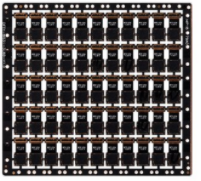Using different resin systems and material substrates, different resin systems, when the copper treatment sinks, there will be a significant difference in the activation effect and copper.
In particular, due to the particularity of some CEM composite substrates and high-frequency silver substrates, some special treatment methods must be adopted in the chemical precipitation of copper. If the normal chemical precipitation of copper is sometimes difficult to achieve good results.
submit
Pretreatment of PCB substrates Some substrates may absorb moisture and the resin cured part of the pressure synthetic substrate is poor. Therefore, when drilling, the resin itself may not be strong enough to cause poor drilling quality, more or more holes. The resin of the hole wall is severely torn, so the material should be baked if necessary.

In addition, some multi-layer laminates may also have poor curing of the pp semi-cured substrate area, which will directly affect the drilling and removal of rubber slag active copper.
Poor drilling conditions, mainly manifested as: hole resin dust, rough hole walls, serious burrs, Konnemau thorns, nail heads of the inner copper foil, and uneven tear length in the glass fiber area, which will cause certain hidden quality problems of chemical copper. In addition to mechanically treating the substrate surface contamination and removing Kongkoma Thorn/Beatles, the brush plate also cleans the surface, and in many cases, it also plays a role in cleaning and removing dust from holes.
In particular, many non-sticky slag treatments of double-sided boards are more important. One more point to note, we don’t think that there is glue and dust that can get out of a slag. In fact, in many cases, the process of removing rubber slag has a very limited effect on the treatment of dust, because the dust in the groove will form A small rubber group makes the groove fluid difficult to handle. The rubber group adsorbed on the hole may also fall off from the hole wall during subsequent processing, which may also lead to a point without copper holes, so for multi-layer and Double-sided board, necessary mechanical brushing and high-pressure cleaning are also necessary, especially in the face of industry, the development trend of small orifice plates and high aspect ratio plates is more and more common. Even sometimes ultrasonic cleaning will eliminate the dust in the hole is a trend.
Reasonable and appropriate removal of the adhesive slag process can greatly improve the hole ratio adhesion and internal connection reliability, but the poor coordination between the PCB glue removal process and the relevant grooves will also bring about some accidental problems. Insufficient removal of slag will cause quality problems such as hole wall micropores, poor inner layer bonding, hole wall shedding, blow holes, etc.; too much glue may also cause glass fibers to protrude in the holes, rough holes, glass fiber cut-off points, and copper leakage, The internal wedge-shaped hole destroys the separation of the inner layer of black copper, causing the hole copper to be broken or discontinuous or the coating wrinkle coating stress increases.
In addition, the coordinated control between several groove fluids is also a very important reason. Insufficient expansion/expansion may lead to insufficient removal of scum; expansion/expansion transitions out to be more able to remove fluffy resin, and then the bad copper will be activated in the sunken copper, even the sunken copper may appear in the post-processing process Defects such as resin sinking and hole wall shedding; for glue tanks, new grooves and higher handling activities may also be some fewer connections. Single-functional resin, dual-functional resin and some tri-functional resins have excessive glue removal phenomenon, which leads to the protruding of glass fiber hole wall, glass fiber is difficult to activate, and the bonding force with chemical copper is inferior to that of resin. The uniform deposition on the substrate will increase the stress of the chemical copper. The most serious thing is that the chemical copper sheet on the hole wall after the copper counterbore is seen peeling off from the hole wall, resulting in no copper production in the subsequent holes. There is no copper open circuit in the PCB hole, which is no stranger to the PCB circuit board industry, but how to control it? Many colleagues have asked many times. Slicing has done a lot of problems, but the problem is still not completely improved, and it is always repeated. Today is the production process, and tomorrow is the process that will arise.